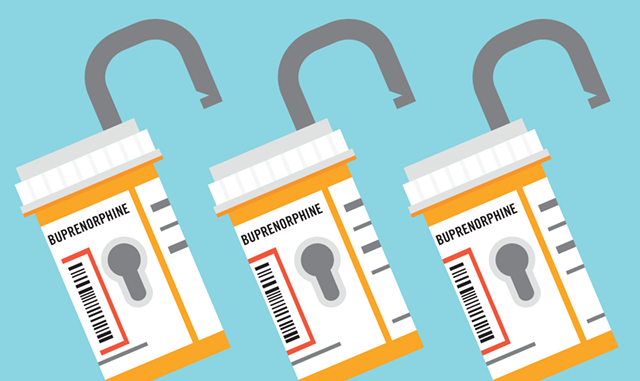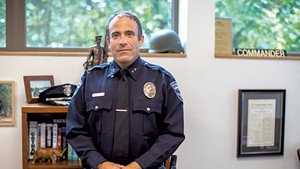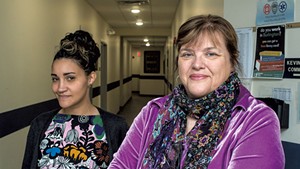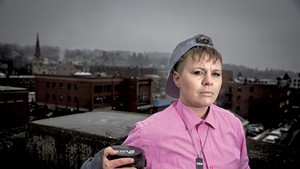
- Dreamstime | Don Eggert
Gregory Shaw was spending $40 a day to buy addiction meds on the street as he waited to start opioid treatment at Rutland's West Ridge Center. When a dealer offered him cocaine instead, the 35-year-old, who had been out on probation, took it — a decision that ultimately landed him back in prison.
Shaw was told he'd remain behind bars for an entire year, dashing his hopes of rebuilding a normal life. "So instead here I sit ... with no treatment or help of any kind," he wrote in an email to Seven Days.
Stories like Shaw's are driving a new effort in Burlington that will give users same-day access to buprenorphine, the opioid addiction medication that Shaw was buying on the street. Officials have decided it's too risky to make people who are addicted to a deadly drug wait even a few days for treatment.
As part of the program's unveiling, Chittenden County State's Attorney Sarah George is announcing that her office won't prosecute anyone for possessing the prescription drug illegally. Her conclusion: It's safer for someone to self-medicate than not to take the medication at all.
"That is a huge, huge step," said Tom Dalton, executive director of Vermonters for Criminal Justice Reform. "It's a paradigm shift."
Dr. Joshua Sharfstein, the director of Johns Hopkins University's Bloomberg American Health Initiative, said the effort would make Burlington "one of a handful of cities really trying to get treatment right to the point of impact."
Last week, George, Burlington Mayor Miro Weinberger, Police Chief Brandon del Pozo, emergency room physician Dr. Stephen Leffler and four other key players sat down with Seven Days to share the details of the program, which is scheduled to start in August.
"This strategy," the mayor said, "is very focused on keeping people from dying."
While Vermont has done more than most states to address the opioid crisis, it hasn't managed to bring down its death toll. According to the Vermont Department of Health, 107 people died of opioid-related overdoses in 2017, one more than in the previous year; 75 people died in 2015. The department estimates that fewer than 8,000 of the estimated 20,000 to 30,000 people addicted to opioids are receiving treatment.
Part of the problem was a years-long waiting list for medication-assisted treatment. But in September 2017, Vermont officials triumphantly announced that the state had eliminated all waiting lists at its regional treatment clinics (known as "hubs" of the system) by training more doctors (the "spokes") to treat addiction.
But, as Weinberger clarified last week, "The fact that there is no waiting list does not mean that there is no wait."
When someone seeks treatment, it often takes two weeks to get the first dose of medication. The clinics have the capacity to take on new clients but can't always do so immediately because of scheduling challenges, explained Bob Bick, chief executive officer of the Howard Center, Vermont's largest substance abuse treatment provider. Incoming patients must complete an initial screening and an in-person assessment before getting a prescription.
In the meantime, they'll likely inject heroin — or the vastly more potent fentanyl — every six to eight hours. Some of these users overdose and end up at the University of Vermont Medical Center emergency room.
"We resuscitate them. We watch them for four to six hours to make sure that the full effects of whatever brought them to the ER have worn off," said Leffler, who is the chief population health and quality officer for the UVM Health Network. "They usually hate staying that long ... We typically try to refer them into therapy, but ... when we tell them, 'We think you can probably start therapy within two weeks,' that's just a complete nonstarter."
Beginning in August, the UVM Medical Center will become the first hospital in Vermont to offer buprenorphine in its emergency room and one of a small number of hospitals doing so nationally. Those who overdose will be able to leave the hospital with a three-day buprenorphine prescription and a guarantee that they can get ongoing treatment, or a refill, after the last dose. The medication is meant to act as a bridge, keeping patients off heroin while the hospital works with the Howard Center to line up a permanent treatment plan.
Six emergency room doctors have already been through an eight-hour tutorial to better understand the pharmacology of the drug and the regulations around it. The hospital is planning to train six more, which would allow it to have a prescriber on-hand 24-7.
"It's a philosophical change," Leffler said. "We're going to manage this as a chronic illness like diabetes and hypertension. We don't send people home without medicines."
The Howard Center is also preparing to provide buprenorphine prescriptions at Safe Recovery, Vermont's largest syringe exchange and the only one in the state that's open 9 a.m. to 5 p.m. Monday through Friday. Located in a modest house in the city's Old North End, the exchange last year served 1,338 clients from every county in the state and got 228 of them into treatment.
Safe Recovery program coordinator Grace Keller said the facility is looking to hire a medical professional who can prescribe buprenorphine. The strategy mirrors the hospital's: Give people a short-term prescription and then get them into longer-term treatment in a clinic or a doctor's office.
"We really need to meet these clients where they are and make treatment as easily available to them as possible," Keller said. "We find the hardest thing for people is that first step. It's making that first step easier."
The cost of the program will be minimal — just $150,000 in the first year, according to Weinberger, who said the city expects to seek funds from state and local sources.
The mayor and his partners aren't concerned about people trying to game the new system. "There would be no reason ever to withhold these pills from somebody, because we know taking buprenorphine is much safer than using heroin or fentanyl," Leffler said.
Approved by the U.S. Food & Drug Administration in 2002, buprenorphine, also known by the commercial name Suboxone, is an opioid that mitigates heroin withdrawal symptoms and cravings. It comes as a pill or dissolvable strip, and any doctor who completes the federally required eight-hour training can prescribe it — unlike methadone, an older opioid addiction medication that must be dispensed at a clinic.
Buprenorphine is considered very safe, and overdoses on it are extremely rare. But the medication isn't universally embraced. It's a mild opioid and can be abused, leading skeptics to conclude that the medication simply supplants one drug for another.
Addiction specialists have worked hard to dispel that notion, pointing to the many studies that show that both buprenorphine and methadone are the most effective treatments for opioid addiction. People taking the medications are less likely to relapse than those who stop taking opioids altogether.
"We don't want to purport that this strategy will solve the opioid crisis," said del Pozo, the police chief. Comparing the approach to the distribution of condoms during the AIDS crisis or bottled water during a cholera outbreak, he made the case that it "isn't the lasting solution, but it stops the spread of infection and keeps people alive."
Unlike water or condoms, though, buprenorphine is a drug that's illegal without a prescription, making this particular effort a bit more complicated. The drug is sometimes "diverted," meaning that someone with a prescription sells or gives it to someone without one.
Crucially, both del Pozo and George have decided to embrace the fact that there's an active black market for buprenorphine. Because the prescription drug is more expensive than heroin and because it generally won't get an opioid addict high, they suggested that most street buyers are trying to stay clean.
"I believe we need to be encouraging diversion," George said. In other words, she won't prosecute buprenorphine cases. That decision should discourage police from arresting and charging people in the first place.
Del Pozo is on board. "Buprenorphine out there being ingested by someone who would otherwise be addicted to heroin is a plus, even if it's a result of diversion," said the police chief. "We're not gonna charge it. We're not gonna ask where they got it from."
The new policy will have a profound impact, according to Dalton of Vermonters for Criminal Justice Reform. Opioid users will be more inclined to choose buprenorphine over heroin when they know with certainty that taking the former won't land them in prison, he reasoned.
Ironically, while top law enforcement officials are willing to overlook criminal activity in the interest of public health, the Vermont Department of Health appears reluctant to embrace their approach.
Tony Folland, manager of clinical services for the department's Division of Alcohol & Drug Abuse Programs, said he wasn't familiar with the details of the Burlington initiative, but he suggested it's still important to discourage the misuse of medications.
While buprenorphine is a highly effective medication for people battling addiction, Folland asserted that "there is another subset of people who are using this, as they would any other narcotic, to get high." He also noted that the state has rules for prescribing buprenorphine, which require that doctors take steps to minimize the possibility that the drug is diverted.
Weinberger acknowledged that the effort to make buprenorphine widely available could make it more likely that nonusers encounter the medication and develop an addiction. But, he added, "We think that is going to be a very rare circumstance."
There's a simple metric by which Vermont can measure whether the new approach is working, according to del Pozo, who said matter-of-factly: "Fewer people dying."














Comments
Showing 1-1 of 1
Comments are closed.
From 2014-2020, Seven Days allowed readers to comment on all stories posted on our website. While we've appreciated the suggestions and insights, right now Seven Days is prioritizing our core mission — producing high-quality, responsible local journalism — over moderating online debates between readers.
To criticize, correct or praise our reporting, please send us a letter to the editor or send us a tip. We’ll check it out and report the results.
Online comments may return when we have better tech tools for managing them. Thanks for reading.